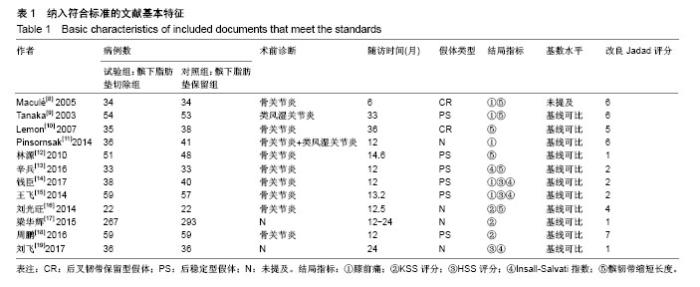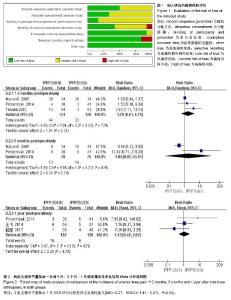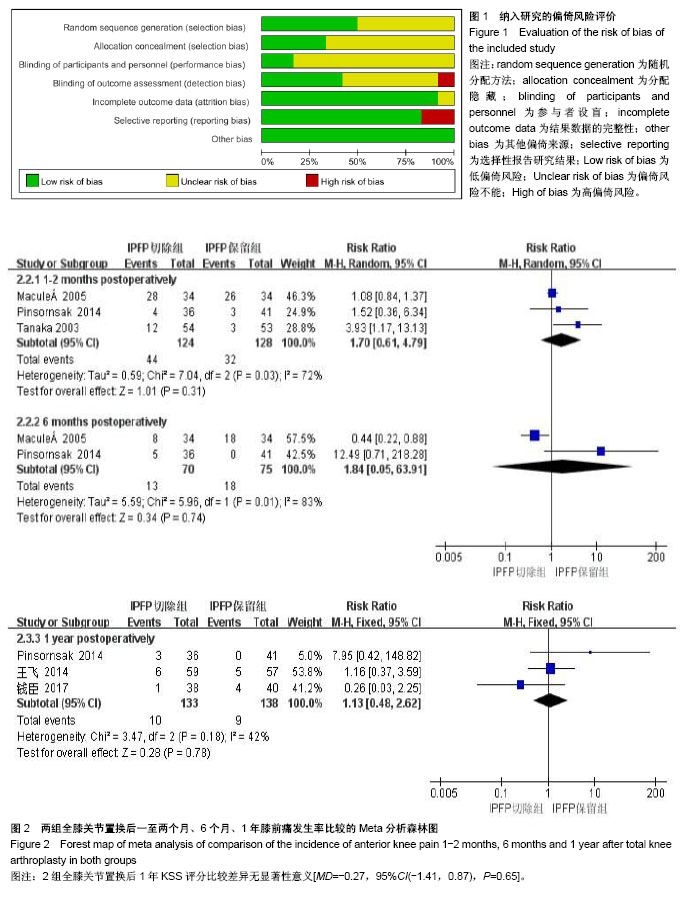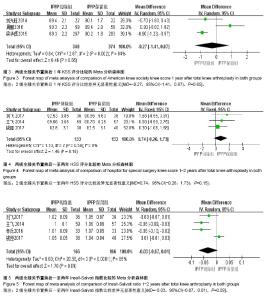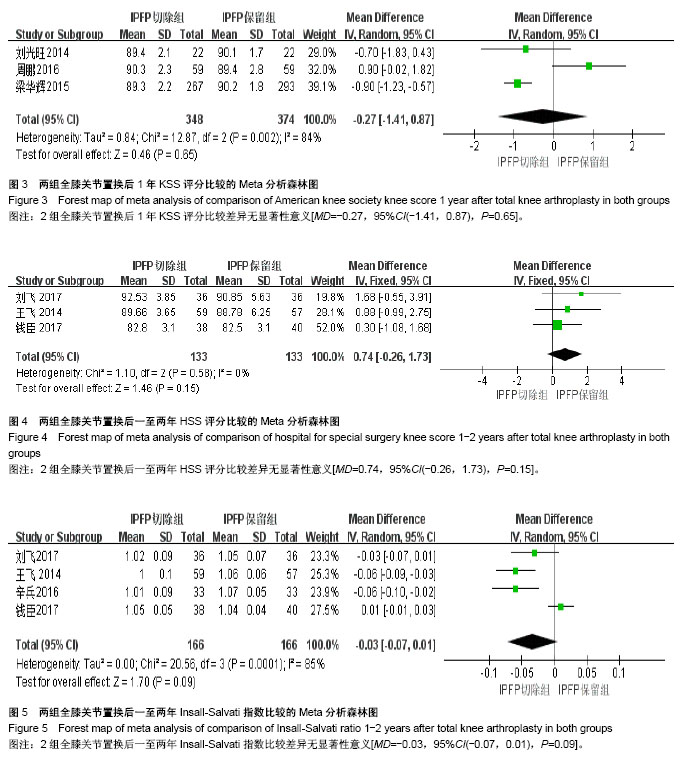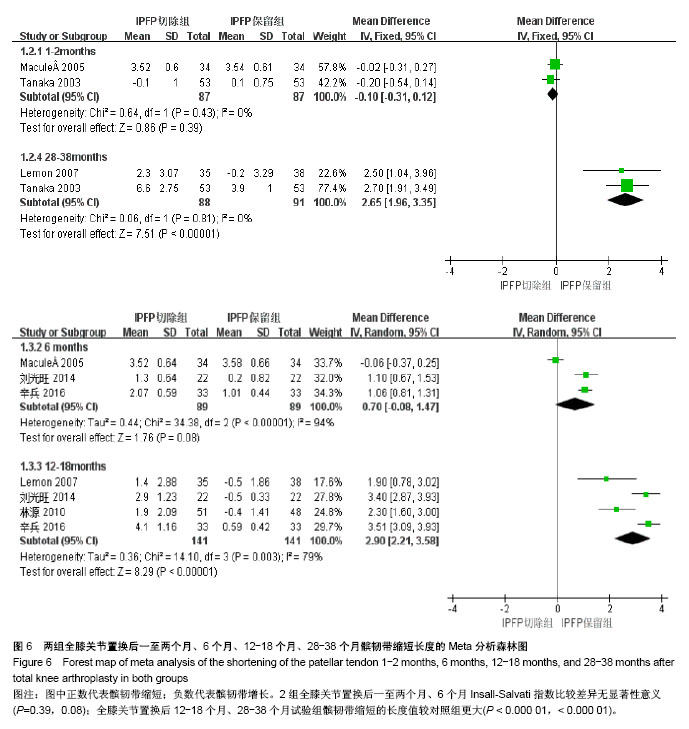| [1] McCalden RW, Hart GP, MacDonald SJ,et al.Clinical results and survivorship of the GENESIS II total knee arthroplasty at a minimum of 15 years.J Arthroplasty.2017;32(7):2161-2166.[2] Ritter MA, Keating EM, Sueyoshi T,et al.Twenty-five-years and greater, results after nonmodular cemented total knee arthroplasty.J Arthroplasty.2016;31(10):2199-2202. [3] Chonko DJ,Lombardi Jr AV,Berend KR.Patella baja and total knee arthroplasty (TKA): etiology, diagnosis, and management. Surg Technol Int. 2004;12:231-238.[4] 张志伟,焦强,张民,等.髌下脂肪垫在膝骨关节炎及全膝关节置换术中作用的研究进展[J].中华外科杂志,2016, 54(4):309-312.[5] Seo JG, Lee SA, Moon YW,et al.Infrapatellar fat pad preservation reduces wound complications after minimally invasive total knee arthroplasty. Arch Orthop Trauma Surg. 2015;135(8) :1157-1162.[6] ?mren Y, Dedeo?lu SS, Çakar M,et al.Infrapatellar fat pad excision during total knee arthroplasty did not alter the patellar tendon length: a 5-year follow-up study.J Knee Surg. 2016;30(05):479-483.[7] Jadad AR, Moore RA, Carroll D,et al.Assessing the quality of reports of randomized clinical trials: is blinding necessary? Control Clin Trials. 1996;17:1-12.[8] Maculé F, Sastre S, Lasurt S,et al.Hoffa's fat pad resection in total knee arthroplasty.Acta Orthopaedica Belgica. 2005;71(6):714-717.[9] Tanaka N, Sakahashi H, Sato E,et al.Influence of the infrapatellar fat pad resection in a synovectomy during total knee arthroplasty in patients with rheumatoid arthritis. J Arthroplasty. 2003;18(7):897-902.[10] Lemon M, Packham I, Narang K,et al.Patellar tendon length after knee arthroplasty with and without preservation of the infrapatellar fat pad. J Arthroplasty.2003;18(7):897-902.[11] Pinsornsak P, Naratrikun K, Chumchuen S.The effect of infrapatellar fat pad excision on complications after minimally invasive TKA: a randomized controlled trial. Clin Orthop Relat Res. 2014;472(2):695-701.[12] 林源,王进军.在全膝关节置换术中保留和切除髌下脂肪垫对髌腱长度的影响[J].临床外科杂志,2010,18(5):339-341.[13] 辛兵,付广宇,王子栋. 研究保留或切除髌下脂肪垫对全膝关节置换术术后髌骨高度的影响[J].中国实用医药, 2016,11(3): 46-47.[14] 钱臣.全膝关节置换术中髌下脂肪垫切除对临床疗效的影响[J].江苏医药,2017,43(10):694-696.[15] 王飞.髌下脂肪垫对全膝关节置换术后髌骨高度及膝关节功能的影响[D].郑州大学,2014.[16] 刘光旺,郭含军,许永,等.髌下脂肪垫对骨关节炎患者全膝置换术后关节功能的影响[J]. 中国矫形外科杂志,2014,22(3):225-229. [17] 梁华辉,唐剑邦,高大伟. 髌下脂肪垫对全膝关节置换术后关节功能的影响[J]. 中国继续医学教育,2015,7(33):96-97.[18] 周鹏,赵辉,吴宇黎,等.髌下脂肪垫切除对全膝关节置换预后的影响[J].骨科,2016,7(5):303-307.[19] 刘飞,黄彰,江华,等. 人工全膝置换术中髌下脂肪垫保留与切除的对比研究[J]. 安徽医药,2017,21(8):1423-1426. [20] Han W, Cai S, Liu Z, et al. Infrapatellar fat pad inthe knee: is local fat good or bad for knee osteoarthritis? Arthritis Res Ther. 2014;16:R145.[21] Ohashi K, Ouchi N, Matsuzawa Y, et al. Anti-inflammatory and anti-atherogenic properties of adiponectin Biochimie. 2012;94:2137-2142.[22] Teichtahl AJ, Wulidasari E, Brady SR,et al. A large infrapatellar fat pad protects against knee pain and lateral tibial cartilage volume loss. Arthritis Res Ther. 2015;17:318.[23] Klein-Wieringa IR,Kloppenburg M,Bastiaansen-Jenniskens YM,et al.The infrapatellar fat pad of patients with osteoarthritis has an inflammatory phenotypeAnn Rheum Dis. 2011;70(5): 851-857.[24] Hu PF,Chen WP,Tang JL,et al.Apelin plays a catabolic role on articular cartilage:in vivo and in vitro studies Int J Mol Med. 2010;26(3) :357-363.[25] Bastiaansen-Jenniskens YM, Clockaerts S, Feijt C, et al. Infrapatellarfat pad of patients with end-stage osteoarthritis inhibits catabolic mediators in cartilage.Ann Rheum Dis. 2012;71(2): 288-294.[26] 林宇进,高兴华,黄保华,等.髌下脂肪垫血供特点及在TKA术中的意义[J]. 中国临床解剖学杂志,2011,29(1):31-33.[27] Liu YP, Li SZ, Yuan F,et al. Infrapatellar fat pad may be with tendon repairing ability and closely related with the developing process of patella Baja. Med Hypotheses. 2011; 77:620-623.[28] Favero M, El-Hadi H, Belluzzi E, et al. Infrapatellar fat pad features in osteoarthritis: a histopathological and molecular study. Rheumatology (Oxford). 2017;56(10):1784-1793.[29] 郭瑞鹏,徐斌.髌骨高度的测量及高位髌骨的研究进展[J].中国组织工程研究,2014,18(20):3269-3274.[30] White L, Holyoak R, Sant J,et al.The effect of infrapatellar fat pad resection on outcomes post-total knee arthroplasty: a systematic review.Arch Orthop Trauma Surg. 2016;136(5): 701-708. [31] Van Beeck A, Clockaerts S, Somville J, et al. Does infrapatellar fat pad resection in total knee arthroplasty impair clinical outcome? A systematic review. Knee. 2013;20(4): 226-231. [32] Cabral F, Sousa-Pinto B, Pinto R, et al. Patellar height after total knee arthroplasty: comparison of 3 methods. J Arthroplasty. 2017;32(2):552-557. |
